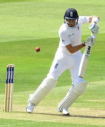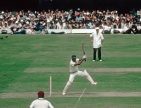India, West Indies and the ‘other’ 1983 – Part 2
Gareth Bland |
When India finally made their way back to New Delhi for a World Cup victory reception with prime minister Indira Gandhi on 5 July 1983, adrenalin must have masked the fatigue felt by Kapil Dev’s squad. Having first attended a felicitation ceremony in Mumbai a week earlier on 28 June, the team were feted as no other Indian athletes had been before. Ahead of them, though, was a grueling schedule. A Pakistan team led by Zaheer Abbass would arrive for three Tests and three limited overs encounters in early September, while Clive Lloyd’s West Indies would follow shortly after. The breeze block-sized third edition of the Benson and Hedges Cricket Year, which covered 1983/84, was quick to note:
“It took India fourteen years to play her first nine Test matches. In three and a half months at the end of 1983 she engaged in the same number. It took India four years and a World Cup tournament to play her first eight one-day internationals, the same number she played between September and December 1983. Such has been the growth of international cricket in the past decade.”
In the three Test series with Pakistan that September honours were even, with neither side able to notch a victory on surfaces seemingly designed to suit the prodigious batting talents of both teams. India did however manage to continue the kind of ODI form which had won them the World Cup months earlier when they brushed their neighbours aside for a 3-0 series clean sweep. No-one in Indian cricket was fooling themselves that this was a challenge comparable to that which they would face in the latter half of the home season, though.
Without the injured Imran Khan, the Pakistani attack did not possess the same potency it had the season before, nor did it carry the same threat to life and limb which that season’s other tourists would represent. Although West Indies were touring minus the injured Joel Garner, reinforcements came in the form of Wayne Daniel and Winston Davis, so that the formidable trio of Andy Roberts, Michael Holding, and Malcolm Marshall still had the back-up to form an irresistible pace battery.
On 13 October 1983 the Jammu and Kashmir city of Srinagar hosted the first limited overs meeting between the new world champions and West Indies since the World Cup final less than four months earlier. For West Indies Roberts, Holding and Marshall were joined by the Leeward Islands fast-medium bowler Eldine Baptiste and Guyanese off-spinner and fielder extraordinaire Roger Harper, along with a batting line-up consisting of the usual suspects. Bundled out for 176 in the 42nd over of their innings, India’s players were given the bird by the home crowd for their dismal batting performance, while they fared no better with the ball as Greenidge and Haynes cruised to 108-0 in reply when bad light curtailed the game, and the tourists were declared winners on account of a superior scoring rate.
The first Test at Kanpur began just eight days after the opening ODI and would serve as a kind of template for West Indian Test victories over the next two years. The tourists lost Andy Roberts to a back strain during net practice and Clive Lloyd opted to bat on winning the toss. Wobbling at 157-5, Greenidge and Dujon steadied the ship to add 152. Following Dujon’s dismissal for 81, Malcolm Marshall made a Test best 92, while Greenidge ran up his own highest score of 194. In reply the Indian collapse was stunning as the first six wickets fell for 49.
Although some brave hitting from Madan Lal and Roger Binny saved face, the home side were dismissed for 207 by Marshall, Holding, Winston Davis and Eldine Baptiste. Another meek offering in the follow-on meant India crumbled to 164 all out, having recovered from a position of 43-5. The hero of the previous year, and man of the match in the World Cup final, Mohinder Amarnath, had also suffered a pair. West Indies had won the match by an innings and 83 runs with Malcom Marshall named man of the match for his first innings 92 and his match bowling figures of 8-66.
Little that Marshall did had as much effect on Indian morale as his delivery to Gavaskar early in the Indian second innings which was delivered with such speed and ferocity that it knocked the bat out of the great opener’s hands. Although his teammates were clearly shaken, the 34-year-old used the incident as a way of introducing a very different mode of operation than that for which he was famed at the top of the order. The results of Sunil Gavaskar’s tactical and technical volte face were to become thrillingly apparent in the second Test in New Delhi.
India batted first in New Delhi, with Gaekwad opening with Gavaskar on a placid surface. Although Gaekwad fell with the score on 28, Vengsarkar joined Gavaskar in a stand of 178 for the second wicket. Utilising his full array of strokes – some of which were thought to be extinct – Gavaskar carved into the West Indian attack in thrilling fashion, hitting 15 fours and 2 sixes, including hook shots off Marshall very early in the piece. Such was his mastery that his half-century came up in just 37 balls, while his overall scoring rate was 94.53, a rate of knots which was other-worldly at the time, especially for an opening bat. It was an audacious way to equal Sir Donald Bradman’s record of twenty-nine Test centuries, coming in his ninety-fifth Test. India eventually finished on 464, with Vengsarkar making a Test best 159, while poor Amarnath failed again, albeit having managed to eke out a single on this occasion.
In reply West Indies made 384 with skipper Lloyd’s 103 and Logie’s 63 being the best efforts after Richards had earlier threatened to tear the Indian attack apart with a six and eight fours in his 67. In India’s second innings the West Indies pace quartet turned the screws so that India could only muster 233, with Amarnath again failing, this time for his third duck in four innings. Chasing an improbable 314 to win West Indies ran out of time and finished on 120-2. Despite Gavaskar’s first innings pyrotechnics it was Vengsarkar who came away with the man of the match award, having added a solid 63 in the second knock to his first innings century.
Having narrowly edged the third limited overs international in Baroda, West Indies travelled to Ahmedabad for the third Test match, where India were without the injured Vengsarkar and the unfit and badly out of sorts Amarnath. In their place a Test debut was given to Navjot Singh Sidhu while Kapil Dev elected to bowl on a wicket that appeared conducive to seam. West Indies were thankful once more to captain Lloyd for his 68, while Dujon once again commanded respect with 98.
Closing their innings on 281, West Indies took to the field as Gaekwad and his senior partner Gavaskar opened the Indian first innings. Once again eschewing attrition in favour of outright aggression, Gavaskar took the attack to the Windies bowlers with another calculated assault. In an opening stand of 127 Gaekwad was first out for 39, clean bowled by Holding. Gavaskar departed shortly afterwards following a 120-ball innings of 90 and the Indian innings collapsed to 241 all out on a pitch which was becoming increasingly unpredictable.
West Indies second innings was notable for a Herculean effort of endurance from Kapil Dev who exploited a wearing pitch to take 9-83 in the total of 201. The Indian captain had bowled unchanged throughout the innings and no West Indian top order bat had topped 33 until Michael Holding unleashed one of his late order specials to smash 58 batting at number 9. Needing 282 to win India were aways up against it and so it proved as only a brave last wicket stand of 40 between Syed Kirmani and Maninder Sigh took the hosts past 100. Two-nil up after three Tests, West Indies simply looked on a different level to any other outfit playing international cricket, with the World Cup in the English summer now receding into memory alarmingly quickly.
The Fourth Test in Mumbai was drawn, with India welcoming the returning Ashok Malhotra and off-spinner Shivlal Yadav. Their first innings 463 was largely due to a rapid even hundred from Vengsarkar, a solid 48 from Gaekwad, who aided Vengarkar in a 133 second wicket partnership, and half-centuries from Shastri and Binny. In the West Indies reply, a Richards hundred was buttressed by the dependable contributions of Lloyd once more, and the increasingly integral Dujon, who made 84. In their second knock Kapil’s team declared at 173-5 on a deteriorating pitch, leaving Windies to chase 244 in just over two and a half hours. Losing the top four for just 68, Lloyd instructed his men to shut up shop and the innings eventually finished on 104-4.
Having been soundly thumped by eight wickets in the 3rd ODI in Indore, and then by 104 runs in the fourth game in Jamshedpur, where Richards and Greenidge hit thirty fours and eight sixes between them, India moved on to Kolkata for the fifth Test. Andy Roberts returned at last, while Mohinder Amarnath was recalled yet again by the Indian selectors.
India won the toss, elected to bat and found themselves in immediate trouble as they slid to 63-6. Brave hitting by Binny (44), Kapil Dev (69) and Syed Kirmani (49) dug them out of a hole, and they eventually scrambled to 241 all out. West Indies’ response was not immediately any better and they slid to 88-5 when Malcolm Marshall joined Clive Lloyd, whose leadership with the bat on this tour scaled new heights, even for this most redoubtable of figures. Time and again he had led his team out of a top order collapse and this innings was once of his finest.
When Marshall was dismissed for 54, and Harper and Holding were sent back shortly afterwards, the returning Roberts joined his captain in a ninth wicket stand of 161. Lloyd was still undefeated on 161 when the last wicket fell at 377, giving his team a first innings lead of 136. With a rest day to follow India hoped to negotiate the remaining passage of play on the third afternoon unscathed. It was a forlorn hope as Marshall and Holding bowled with a discomforting intensity that those who witnessed it have not forgotten. Writing in 2013, Indian cricket writer Samir Chopra recalled that Kolkata afternoon:
“This time the destroyer was Michael Holding. First to go was Gaekwad, cleaned up comprehensively. India 14 for 1. Gavaskar, sensing trouble, had been playing his strokes, perhaps hoping to replicate his heroics in Delhi, where he had belted a dramatic century off the same attack in the second Test. This time, though, he was out ingloriously, slashing at a wide one and caught behind (and earning himself the unjust jeering of those who thought he had been unduly reckless.) India 29 for 2.
Almost immediately Vengsarkar was trapped leg-before by Marshall. India 29 for 3. But it was the fourth wicket that finally completed that day’s gloom. Amarnath had walked out on the back of a string of scores that read 0, 0, 0, 1, 0. A few balls later, he had his fifth duck of the series. To this day, I have not seen a more spectacular instance of a batsman being bowled: both his off and middle stump were sent flying – the off-stump cartwheeling toward slips, the middle toward the keeper.
By now, I was used to West Indian fast bowlers dominating Indian batsmen. But this dismissal, this contemptuous removal of a man who had stood up to their might again and again, was the last straw. The sense of threat in the air was palpable; the West Indians looked and felt merciless. The light was poor, rounding out the doom and despondency that now infected Indian spirits. The game was up”
The game was indeed up for India as they were cleaned up for 90 all out, losing by an innings and 46 runs. Just as the crowd had grown increasingly short-tempered with the home side’s performance in the preceding ODI in Jamshedpur, they had almost reached boiling point in this Test match. As Gavaskar swished his way to 20 in the doomed second innings in Kolkata, his dismissal to a catch behind off Holding was greeted with undisguised contempt and hostility by the crowd.
The final ODI in Gauhati was another stroll for the visitors, who chased down the required 178 to win by six wickets. Kirmani captained India in the absence of Kapil and Gavaskar, while Richards led West Indies. In the final Test in Chennai which followed rain managed to wash out the opening day and have a significant say in the other four. Batting first, the entire West Indies top order got a start although only Dujon, with 62, passed the thirties. Bowled out for 313 West Indies then set to work on the Indian batting line-up.
The Indian board had acceded to Gavaskar’s request to drop down the order, although he must have been less than impressed to still be walking out – at number four – with the score on 0. Over ten and a half hours of batting later, however, he walked back, undefeated, on 236, having achieved his highest Test score and what was at that time the highest Test score made by an Indian. Kapil Dev’s side had justly drawn this final Test, although with innings victories in Kanpur, Ahmedabad and Kolkata, Clive Lloyd’s men achieved a magnificent 3-0 series win.
It had been a grueling series for the home team. Being blown apart in Tests and in the limited overs series was surely not the way the romantics would have scripted the honeymoon season which followed world cup triumph just months earlier. They had, however, run up against incredible opposition in the form of Clive Lloyd’s team. If West Indies occasionally had holes in their batting, then someone would always come along to plug the gaps and dig them out of trouble. In 1983/84 that someone was the captain himself, Clive Lloyd, who struck 496 at 82.66 in this series. Dujon, too, had come of age and had finished the series with 367 at 52.42, while Greenidge was flourishing into the all-round opening bat he had always promised to become. In this series the great Barbados opener had contributed 411 runs at 51.37, with his best yet to come.
With the ball the fast-learning Malcolm Marshall was now unequivocally the spearhead, having taken 33 wickets at 18.81 during the Test series. Additionally, that miracle of biomechanics, the Michael Holding bowling action, seemed not to suffer at all from the reduced propulsion of a short run-up as he still bowled with express pace to take 30 wickets at 22.10. The only possible dimming of the light on the West Indian horizon was the retirement of Andy Roberts, although even there the resting Joel Garner would be back for the West Indian home summer in early 1984.
For India, their bowling had been shown to be almost totally reliant on Kapil Dev. Rising to that challenge, he had taken 29 wickets at 18.51, although no other Indian bowler took more than 12 wickets in the series, and that was the slow-left arm of Ravi Shastri. India’s decline since the World Cup was embodied by Mohinder Amarnath, and no player’s collapse in form had been so precipitous. In six Test innings he scored just a single run and was even briefly renamed “Amarnought”. However, tough nut that he was, he would come again.
In this series, Gavaskar and Vengsarkar justly took the batting plaudits for the home team. Notching 505 runs at 50.50 the great opener had resurrected the youthful dasher in himself to work in tandem with the technical behemoth, although it was the dasher who would come more often to the fore in the remaining years of Sunil Gavaskar’s career.
If the Indian crowds expressed their annoyance and frustration with their heroes out on the field in this series, it was of course a direct consequence of their totemic achievement in the English summer of 1983. Watching on two years earlier in 1981/82 as England toured India, Scyld Berry had observed “Was there a groundswell turning in favour of watching and playing the game which would come to alter the existing shape of the cricket map? While Australia was the most progressive Test-playing country, West Indies the strongest, and England still leading in the game’s administration, was India soon to rival them?”
As a cricketing giant in India had stirred, and as the financial locus of the game would inexorably begin its pivot eastward, the 1983 World Cup had whetted the appetite of the Indian cricket public. For, as Ranveer Singh’s Kapil Dev would famously say in 83, the film about India’s world cup triumph, “Like people says, taste the success once…tongue wants more”





Leave a comment